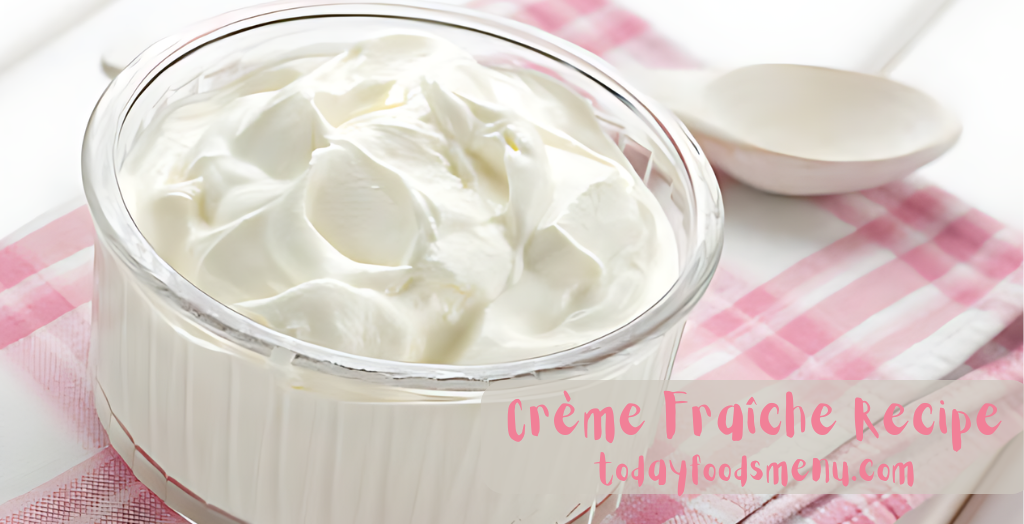Introduction
Crème fraîche is a delightful ingredient that can elevate various dishes with its creamy texture and tangy flavor. If you want to make your own, this comprehensive guide will walk you through crafting the perfect crème fraîche recipe. We’ll delve into the history, science, and a detailed crème fraîche recipe, as well as provide tips for successful fermentation and creative ways to use your homemade crème fraîche.
What is Crème Fraîche?
Before diving into the crème fraîche recipe, it’s essential to understand what crème fraîche is. Crème fraîche is a cultured dairy product known for its rich, creamy texture and slightly tangy flavor. It is similar to sour cream but with a higher fat content, making it less acidic and more luxurious. Making crème fraîche involves fermenting heavy cream with specific bacterial cultures, resulting in a product that’s perfect for cooking and baking.
The History of Crème Fraîche
The origins of crème fraîche trace back to French culinary traditions. Traditionally, crème fraîche was made from raw milk containing lactic acid bacteria. Over time, with improvements in food safety, the process evolved to include pasteurization and specific bacterial cultures. Today, making crème fraîche at home allows you to enjoy a traditional ingredient with the freshest taste and texture.
The Science Behind the Crème Fraîche Recipe
Understanding the science behind your crème fraîche recipe can help you achieve the best results. When heavy cream is inoculated with bacterial cultures, these bacteria consume lactose and produce lactic acid. This acid lowers the pH of the cream, causing it to thicken and develop a characteristic tang. The bacterial cultures used in crème fraîche recipes, such as Lactococcus lactis and Leuconostoc mesenteroides, are selected for their ability to produce a smooth and creamy texture.
Ingredients for the Crème Fraîche Recipe
To make your crème fraîche, you will need the following ingredients:
- Heavy Cream – 1 cup (preferably pasteurized, but not ultra-pasteurized).
- Crème Fraîche Starter Culture – 2 tablespoons (store-bought crème fraîche or a commercial starter culture).
- Milk Powder (Optional) – 1 tablespoon (for added thickness, if desired).
Equipment Needed for the Crème Fraîche Recipe
- Glass Jar or Ceramic Bowl – For fermenting the crème fraîche. Ensure it is clean and sterilized.
- Saucepan – For heating the cream. Use a non-reactive pan.
- Thermometer – To monitor the temperature of the cream.
- Whisk or Spoon – Mix the bacterial culture into the cream.
Step-by-Step Crème Fraîche Recipe
Prepare Your Equipment
Start by cleaning and sterilizing your glass jar or ceramic bowl. This ensures that no unwanted bacteria interfere with your crème fraîche recipe. Wash it in hot, soapy water or run it through a dishwasher cycle.
Heat the Cream
Pour 1 cup of heavy cream into a saucepan. Heat the cream over medium-low heat until it reaches approximately 85°F (29°C). This step is crucial for the crème fraîche recipe as it helps dissolve lumps and prepares the cream for fermentation.
Cool the Cream
Remove the saucepan from the heat and let the cream cool to room temperature, around 70°F (21°C). Cooling the cream is essential in the crème fraîche recipe because bacterial cultures need a warm environment to thrive.
Inoculate the Cream
Add two tablespoons of store-bought crème fraîche or the specified commercial starter culture to the cooled cream. If you use milk powder to thicken the crème fraîche, mix it in at this stage. Stir gently to ensure the culture is evenly distributed throughout the cream.
Ferment the Cream
Pour the cream mixture into your prepared jar or bowl. Cover it loosely with a lid or a clean cloth to allow air circulation while protecting the mixture from contaminants. Place the jar in a warm, draft-free area around 70°F (21°C). This is a key step in the crème fraîche recipe, as the right environment will ensure proper fermentation.
Wait for Fermentation
Allow the cream to ferment for 12 to 24 hours. The exact fermentation time may vary based on ambient temperature and bacterial culture strength. The cream will thicken during this period and develop its characteristic tangy flavor.
Check Consistency
After the fermentation period, check the crème fraîche. It should be thickened to a consistency similar to sour cream with a tangy aroma. Let it sit for a few more hours if it hasn’t thickened enough. The consistency is an important aspect of the crème fraîche recipe and should be smooth and creamy.
Refrigerate
Once the crème fraîche has reached the desired consistency, cover it tightly with a lid and refrigerate. Chilling the crème fraîche will further thicken it and enhance its flavor. Homemade crème fraîche can be stored in the refrigerator for uptill two weeks.
Tips for Perfect Crème Fraîche
To ensure that your crème fraîche recipe turns out perfectly, consider these tips:
- Use High-Quality Cream: The quality of your crème fraîche is directly related to the cream you use. Opt for fresh, high-fat heavy cream, and avoid ultra-pasteurized cream if possible.
- Maintain a Consistent Temperature: A stable warm temperature is crucial for successful fermentation. If your kitchen is cold, use a yogurt maker or an oven with the light on to provide a stable environment for the crème fraîche recipe.
- Avoid Over-Stirring: After adding the bacterial culture, stir the mixture gently to avoid disrupting the fermentation process. Excessive stirring can affect the texture of the crème fraîche.
- Experiment with Flavors: Once you’ve mastered the basic crème fraîche recipe, try adding herbs, garlic, or spices to create flavored variations.
Creative Uses for Homemade Crème Fraîche
Your homemade crème fraîche is incredibly versatile. Here are some creative ways to use it:
Soups and Stews
Add crème fraîche to soups and stews for a rich, creamy texture. Stir it into dishes like potato leek soup, creamy tomato soup, or beef stew to enhance the flavor and add depth.
Sauces
Use crème fraîche as a base for sauces to complement pasta, chicken, or fish. For example, make a creamy mushroom sauce by sautéing mushrooms and garlic, then stirring in crème fraîche. It also works well in a dill sauce for fish.
Dressings
Mix crème fraîche with herbs, lemon juice, and seasonings to create delicious salad dressings. The creamy texture of crème fraîche adds richness to salads without being overly heavy.
Baking
Incorporate crème fraîche into baked goods to improve moisture and create a tender crumb. It’s excellent in cakes, scones, and muffins and can also replace buttermilk in recipes for a unique twist.
Desserts
Crème fraîche can be a luxurious addition to desserts. Use it as a topping for fruit tarts, mix it into cheesecake batter, or serve it alongside fresh berries for a sophisticated treat.
Toppings and Dips
Top baked potatoes, nachos, or tacos with crème fraîche for a creamy, tangy addition. It can also be used as a base for dips, such as a creamy onion dip or a tangy herb dip for vegetables.
Storing and Preserving Crème Fraîche
Proper storage is essential for maintaining the quality of your crème fraîche. Here’s how to keep it fresh:
- Refrigerate Promptly: Store your crème fraîche in an airtight container in the refrigerator as soon as it’s made. This helps keeping it fresh and prevents spoilage.
- Avoid Cross-Contamination: To avoid introducing bacteria, Use a clean utensil each time you scoop crème fraîche from the container.
- Check for Freshness: Always check for signs of spoilage before using crème fraîche. If it develops an off smell, mold, or an unusual texture, then discard it. Properly stored crème fraîche should remain fresh for up to two weeks.
Conclusion
Crafting the perfect crème fraîche recipe at home is a fulfilling process that allows you to enjoy the freshest and most flavorful product. Following this detailed crème fraîche recipe and keeping the tips in mind, you can create a rich, creamy, and tangy ingredient to enhance various dishes. From soups and sauces to desserts and baked goods, homemade crème fraîche is a versatile and valuable addition to your culinary repertoire. So gather your ingredients, follow the steps, and savor the satisfaction of making your crème fraîche from scratch. With this crème fraîche recipe, you can enjoy this classic ingredient’s rich, creamy goodness in all your favorite dishes.


